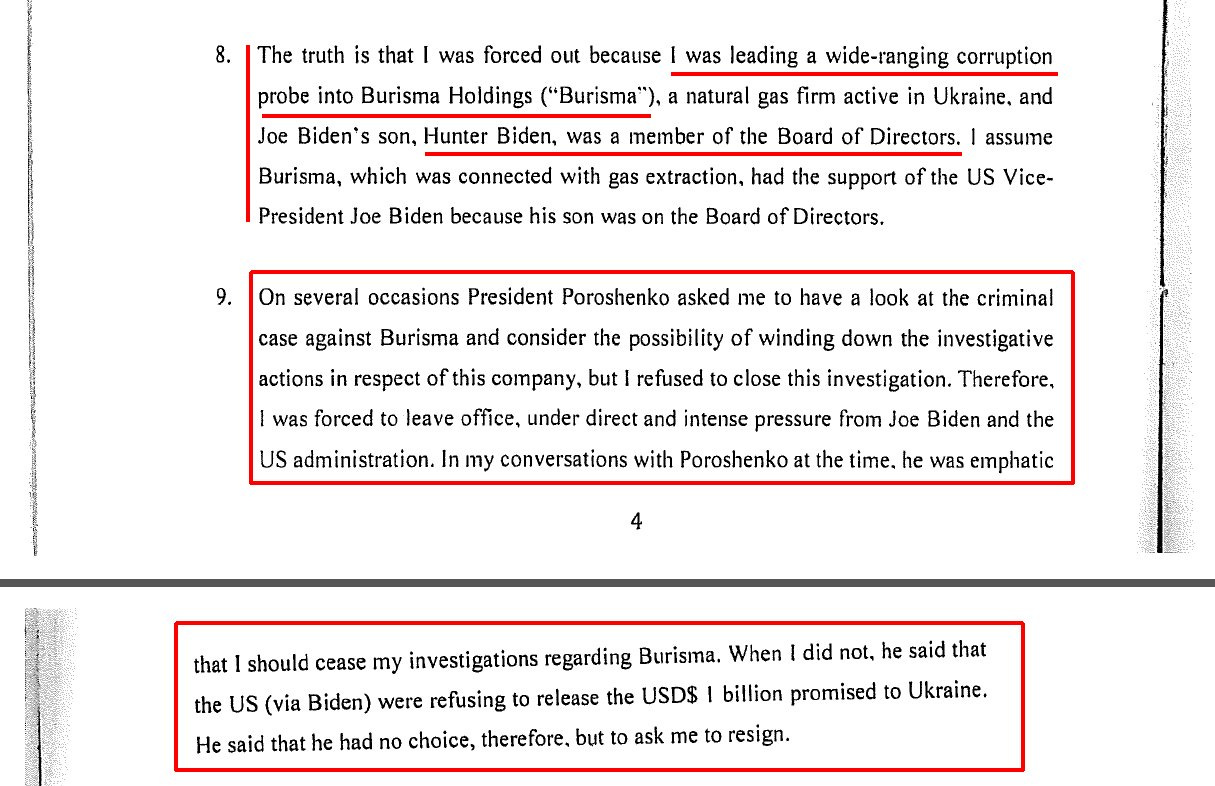There is no doubt, war is ugly. Atrocities are committed by all belligerents involved in conflict.
Propaganda is heightened and intensified not only by the major participants, but also by countries, governments, organisations, corporations, and individuals who aren’t directly involved in the conflict. Each has their own motivations, reasons, and self-serving interests for doing so.
Fog of war – a German expression Nebel des Krieges coined by Prussian general Carl von Clausewitz – is often used to describe the uncertainty in situational awareness experienced by participants in military operations.
The expression can also easily be used to describe the fog that occurs between people’s ears when they are bombarded with propaganda pushed by countless parties which most often completely distorts the true realities of the conflict or war in question.
War is emotional. And when emotions are high and people are gaslighted, reason and judgement are often easily thrown out the window.
The absence or omission of truthful information and picking sides also contributes to a lack of balanced reporting on such conflicts.
Too often, the very powerful mainstream press is incentivised to report a prevailing narrative that, more often than not, serves the vested interests of those to whom they are all too willing to oblige their allegiances to.
Journalists and independent or alternative media outlets that provide reporting that is counter to these prevailing narratives are often labelled as conspiracy theorists or other derogatory labels.
This is done so because those who are attacking them cannot counter the merits of their claims and reporting, and thus must resort to attacking their character instead.
Unfortunately, this is a logical fallacy that most of the general public fall for.
Now for the ugly, inconvenient, truths that the mainstream media refuse to present to their audiences with regards to the Ukraine and the Russia-Ukraine war.
For those not entirely familiar with NATO, or the North Atlantic Treaty Organization, here is a nice summary by Al Jazeera:
“The North Atlantic Treaty Organisation (NATO) was founded in 1949 by 12 member states – Belgium, Canada, Denmark, France, Iceland, Italy, Luxembourg, the Netherlands, Norway, Portugal, the United Kingdom and the United States – and was established to curb Soviet expansion and encourage political integration in Europe in the aftermath of World War II.
The 30-member alliance is meant to guarantee political and military protections, and allow European and North American nations to discuss security concerns.”
One of the main reasons for its existence was to “curb Soviet expansion”, as stated above. The rationale being that the West viewed the Soviet communist system as a grave threat after World War II.
Moreover, as the Soviet Union and the United States were embroiled in the Cold War from 1947 to 1991, the U.S. sought to expand its sphere of political and military influence, particularly in Europe.
After the Dissolution of the Soviet Union in 1991, 15 former Soviet Republics became sovereign states.
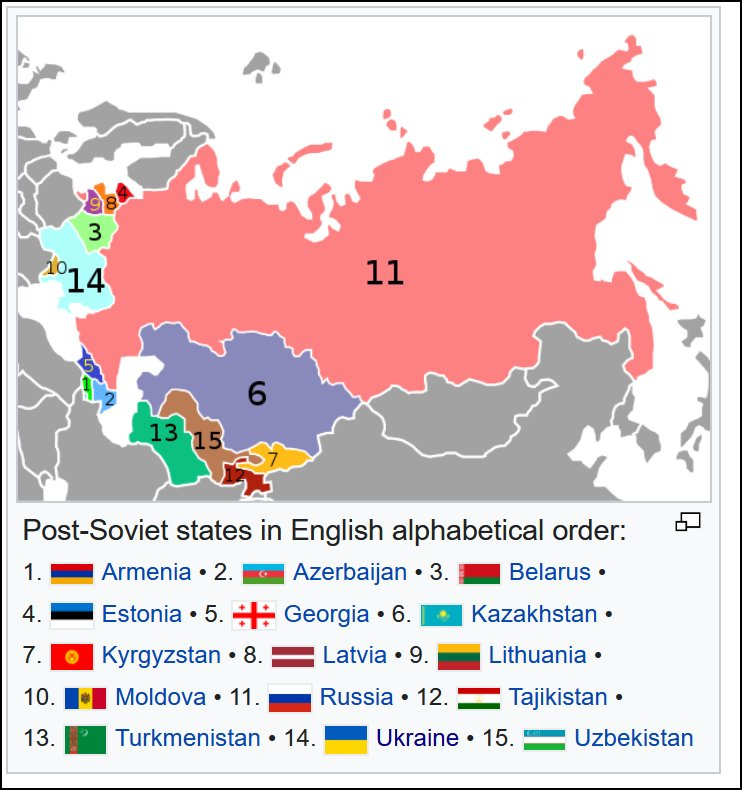
Fifteen post-Soviet states. Source: Wikipedia.
Though many of these states as well as their people have retained close ties with Russia, three of them acceded membership into NATO in 2004; namely, Estonia, Latvia, Lithuania.
Two of these countries, Estonia and Latvia share a border with Russia.
Recall that NATO originally had 12 members.
A CNBC article provides two maps showing the expansion of NATO since 1991 towards Russia. The first map shows Europe in 1990, the year after the Berlin wall fell:
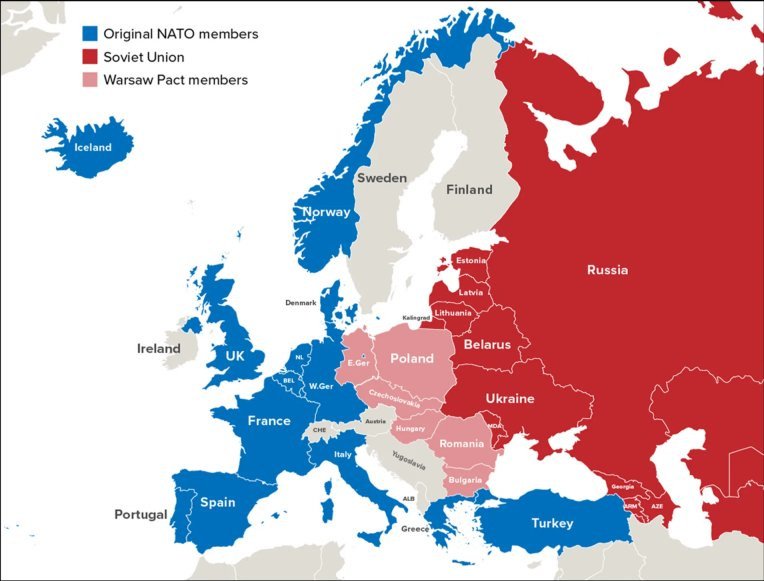
Map of Europe in 1990 showing original NATO countries in blue. Source: Bryn Bache, CNBC.
Their second map, as of 2022, clearly shows the expansion of NATO membership over the past 32 years since the reunification of Germany:
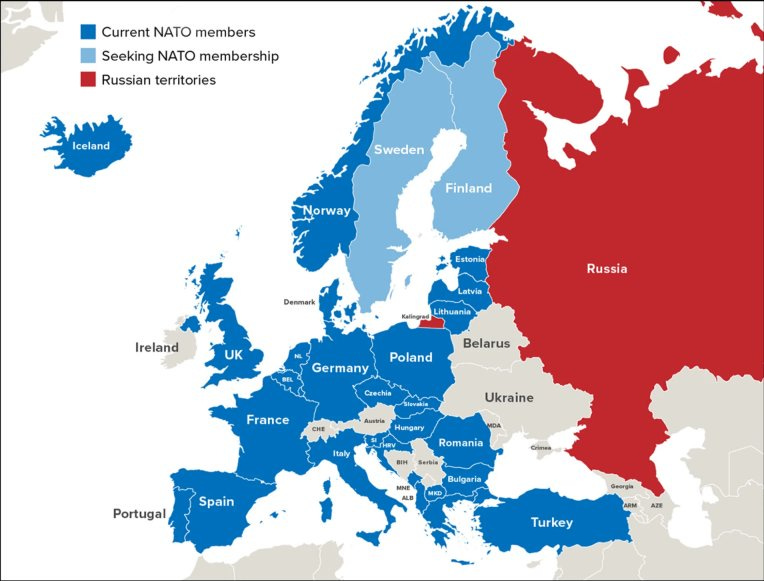
Map of Europe in 2022 showing current NATO countries in blue. Source: Bryn Bache, CNBC.
From this second map above showing 2022 NATO countries in blue, we can also notice Sweden and Finland (in light blue) who are currently vying for NATO membership.
Since the early 1990s, Russia has been worried about NATO expanding closer to its borders.
While various agreements had been made between Russia and Europe not to expand NATO eastward, several of them were broken.
The main worry is that NATO members can have military bases that hold nuclear missiles for which member countries, such as the United States, have an ample supply of.
There is plenty of evidence that confirms that such military bases (particularly from the U.S. and NATO) exist and are located in Russia’s immediate neighbors of Estonia (see also here, here and here), Latvia (see also here, here, here, here, here, here, and here) , and Lithuania (see also here, here, here, here, and here).
U.S. and NATO military bases, personnel, and operations are not limited to these three countries, for there are many more in other NATO countries near Russia such as Poland, Hungary, and Bulgaria.
In recent years, Russian President Vladimir Putin has sought guarantees from NATO and many of its European members that it would halt its eastward expansion and end military cooperation with Ukraine and Georgia, which are not members, observed Al Jazeera.
Both Georgia and the Ukraine share borders with Russia and the latter has a significantly long border with the biggest former member of the Soviet bloc.
It would thus come as no surprise that Russia and its current leader, Vladimir Putin, would consider it more than hostile should either of these two countries were to join NATO.
Many of sound mind would argue that having military bases, some with nuclear arsenals, within only several kilometers from your doorstep poses a significant threat to the safety, protection, and territorial integrity of a nation and its people.
Was this not the case when the Soviet Union had stationed nuclear missiles in Cuba, less than 100 miles away from the United States?
If that was not acceptable to President John F. Kennedy and the U.S. administration, then how is it different for Vladimir Putin, the President of Russia and his administration?
Should they not be granted the same right?
These questions must be considered and contemplated prior to outrightly accusing Putin of “aggression” and invasion against the Ukraine, or any other close neighbor, for that matter.
Also according to the Al Jazeera article, in February [of 2022], Putin said Russia’s “special operation” in Ukraine was a means to stop NATO’s growth, which he perceives as an encroachment.
Only in recent weeks has Putin called the conflict with the Ukraine a war. Perhaps this is so because he had not anticipated the level and extent of Western support Kiev has received over the past year.
While some would argue that the invasion was nevertheless unjustified, ample evidence exists that show that prior promises and agreements to not allow the expansion of NATO eastward were broken by NATO members and NATO itself.
Here are but two of these broken promises which most everyone seems to forget about.
Early last year, a secret document from March 1991 titled QUADRIPARTITE MEETING OF POLITICAL DIRECTORS, BONN, 6, MARCH: SECURITY IN CENTRAL AND EASTERN EUROPE showed a pledge to Moscow by the United States, Germany, France, and the United Kingdom, that they would not extend NATO eastward and would not offer membership to Poland.
The document was found in the UK National Archives by Joshua Shifrinson, a political science professor at Boston University in the US and shared with Der Spiegel. It had been marked “Secret” but was declassified at some point.
Specifically, here is part of what was it stated:
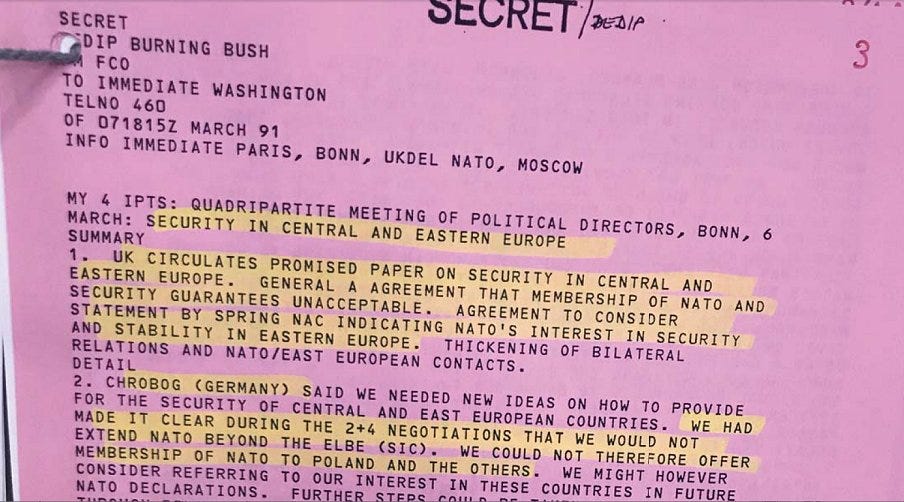
Screenshot of the 1991 QUADRIPARTITE MEETING OF POLITICAL DIRECTORS, BONN, 6, MARCH: SECURITY IN CENTRAL AND EASTERN EUROPE. Source: UCLA College of Social Sciences.
As the reader may notice from the image above, the parties stated: “WE HAD MADE IT CLEAR DURING THE 2+4 NEGOTIATIONS THAT WE WOULD NOT EXTEND NATO BYOND THE ELBE (SIC).”
The “2+4 negotiations” simply refers to the reunification of Germany (i.e., East Germany with West Germany) with NATO remaining an integral part of the reunified country.
In July 2014, NATO itself called the eastward expansion a “myth,” as per its published piece titled NATO enlargement and Russia: myths and realities. In that piece, a few questions were raised about the “enlargement conundrum” [emphasis added]:
“Does the absence of a promise not to enlarge NATO mean that the West never had any obligations vis-à-vis Russia? Did the enlargement policy of Western institutions therefore proceed without taking Russian interests into account? Again, the facts tell a different story.”
The only thing is, NATO was not counting on the QUADRIPARTITE MEETING OF POLITICAL DIRECTORS, BONN, 6, MARCH: SECURITY IN CENTRAL AND EASTERN EUROPE secret document to be released to the public.
In black and white, it confirms that a promise, or agreement, by NATO not to expand did take place.
So, this myth, or “conspiracy theory” turned out to be conspiracy fact.
It is no wonder that Moscow and Putin hold a fervent distrust of NATO, the United States, and its other Western allies.
The secret 1991 document also revealed the following:
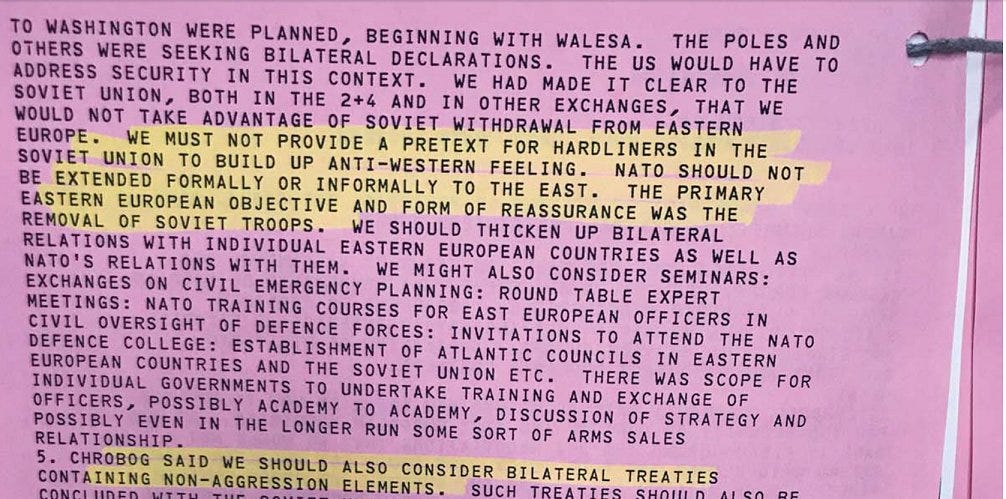
Verbatim [with emphasis added for the most salient points]:
“WE HAD MADE IT CLEAR TO THE SOVIET UNION, BOTH IN THE 2+4 AND IN OTHER EXCHANGES, THAT WE WOULD NOT TAKE ADVANTAGE OF SOVIET WITHDRAWAL FROM EASTERN EUROPE. WE MUST NOT PROVIDE A PRETEXT FOR HARDLINERS IN THE SOVIET UNION TO BUILD UP ANTI-WESTERN FEELING. NATO SHOULD NOT BE EXTENDED FORMALLY OR INFORMALLY TO THE EAST. THE PRIMARY EASTERN EUROPEAN OBJECTIVE AND FORM OF REASSURANCE WAS THE REMOVAL OF SOVIET TROOPS.”
As you can see, the promise was indeed made. The Soviet withdrawal did occur. Yet NATO expanded anyhow, including in Poland for which they had also explicitly stated they would not.
If NATO has lied about this broken promise, then how many others have they lied about and broken? And, more importantly, should they be trusted?
That is not the only promise NATO has broken with Russia.
“The Minsk agreement, which the Russian government backed for diplomatic reasons, has served to allow Washington time to train, equip, and mobilize much stronger forces now preparing to resume the attack on Donetsk and Luhansk,” observed Dr. Paul Craig Roberts, former U.S. Assistant Secretary of the Treasury, former associate editor at The Wall Street Journal, and long time Russia connoisseur, back in 2015.
He was right.
What is the Minsk agreement?
Not to be confused with the 1991 agreement of the same name, the 2015 Minsk agreement was one that aimed to resolve the long-simmering conflict in eastern Ukraine.
The conflict was between pro-Russian separatists mostly from the Donetsk and Luhansk regions who were more ethnically Russian and the Ukrainian government.

Image source: Al Jazeera.
The following passage from Reuters describes the 2015 (Minsk II) agreement in a nutshell:
“Representatives of Russia, Ukraine, the Organisation for Security and Cooperation in Europe (OSCE) and the leaders of two pro-Russian separatist regions signed a 13-point agreement in February 2015 in Minsk. The leaders of France, Germany, Russia and Ukraine gathered there at the same time and issued a declaration of support for the deal.”
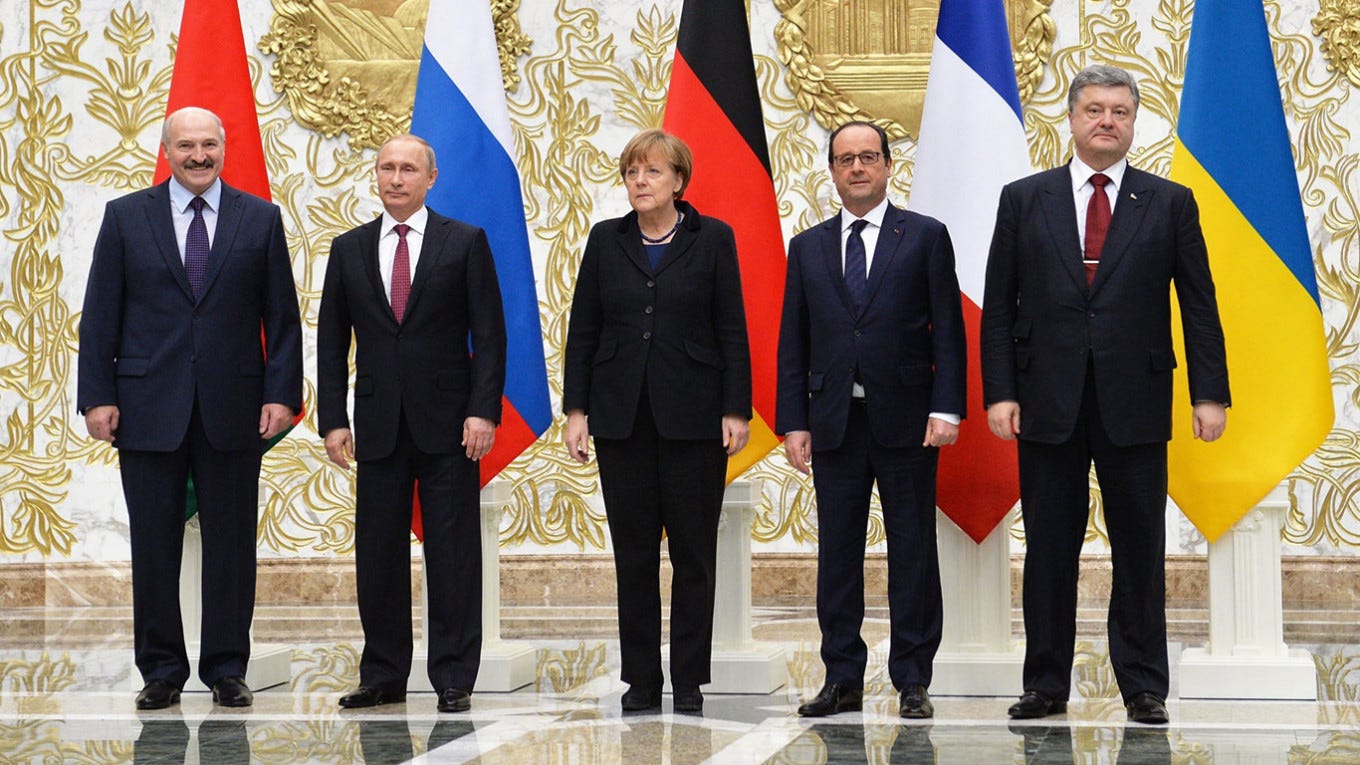
In February 2015, the Minsk II agreements were signed by Belarus’ Alexander Lukashenko, Russia’s Vladimir Putin, Germany’s Angela Merkel, France’s Francois Hollande and Ukraine’s Petro Poroshenko. Source: The Moscow Times.
The agreement ultimately failed.
While which side is the blame is a contentious matter, the Organisation for Security and Cooperation in Europe (OSCE), who was in charge of monitoring the implementation of the ceasefire agreement, determined that the Ukrainian government had repeatedly violated the agreement and around 200 weekly violations in 2016-2020 and more than 1,000 since 2021 occurred, according to Novaya Gazeta.
Though NATO stressed that the Minsk agreements remained “the best chance to settle the conflict,” its actions proved otherwise.
Back in 2015, Jens Stoltenberg, NATO’s Secretary General since 2014, indicated no less than an increase military support to the Ukraine during this so-called ceasefire period, stating “we have stepped up our support to Ukraine on command and control; logistics; cyber defence.”
And more specifically, in June of 2022, Stoltenberg affirmed NATO’s long-time push into Eastern Europe, stating:
“the reality is that we have also been preparing for this since 2014. Because that’s the reason why we have increased our presence in the eastern part of the Alliance, why NATO Allies have started to invest more in defence, and why we have increased the readiness.”
By “increase in the readiness”, Stoltenberg was referring to Russia. On the matter, Robert Bridge, an American writer and journalist for RT noted:
“What he neglected to mention, though, was the role Western powers played in the outbreak of civil violence in Kiev on February 24, 2014 that led to the Maidan coup and, ultimately, to the current situation. The US and its influence on the ground in Ukraine, channelled through “civil society” groups it bankrolled, was largely responsibility for that mess.”
A month before the Russian invasion in 2022, Ukraine’s own security chief, Oleksiy Danilov, warned the West against enforcing the Minsk II peace deal.
Danilov also denounced the Russian demands for NATO to bar Ukraine from ever joining the alliance.
Former opposition MP Ilya Kiva (who had to flee the Ukraine for his stark opposition to Zelenskyy) blamed the Ukrainian President of supporting pro-NATO policies causing the war, allowing Nazism to permeate in the country, and enslaving his own people in the eastern part of the country.
In a March 2022 interview Kiva slammed the U.S. and NATO for “using Ukraine as bait to provoke Russia into a conflict.” He added that Washington and its allies had tricked Zelenskyy which has led to its current state of devastation.
In concluding this section, the Minsk agreements were practically doomed from the start since powerful forces influencing Kyiv, including NATO and many others mentioned in this exposition, really had no sincere interest in helping to establish peace in eastern Ukraine; but were more concerned with continuing their eastward expansion towards Russia’s borders.
After the dissolution of the Soviet Union in 1991, Ukraine became an independent country.
In the years 2013-2014, the Ukraine was at a real crossroads. Geographically-perched between Europe in the west and Russia in the east, alliances were split and there was a lot at stake – economically and geopolitically.
The West was calling for the young country to align itself with European and American interests.
But its President, democratically-elected Ukrainian President Viktor Yanukovych, was instead leaning towards aligning the country’s interests with Russia and Putin.
This was absolutely unacceptable to Western powers and NATO.
Consequently, Ukrainian President Viktor Yanukovych was overthrown in a violent coup on Feb. 21, 2014.
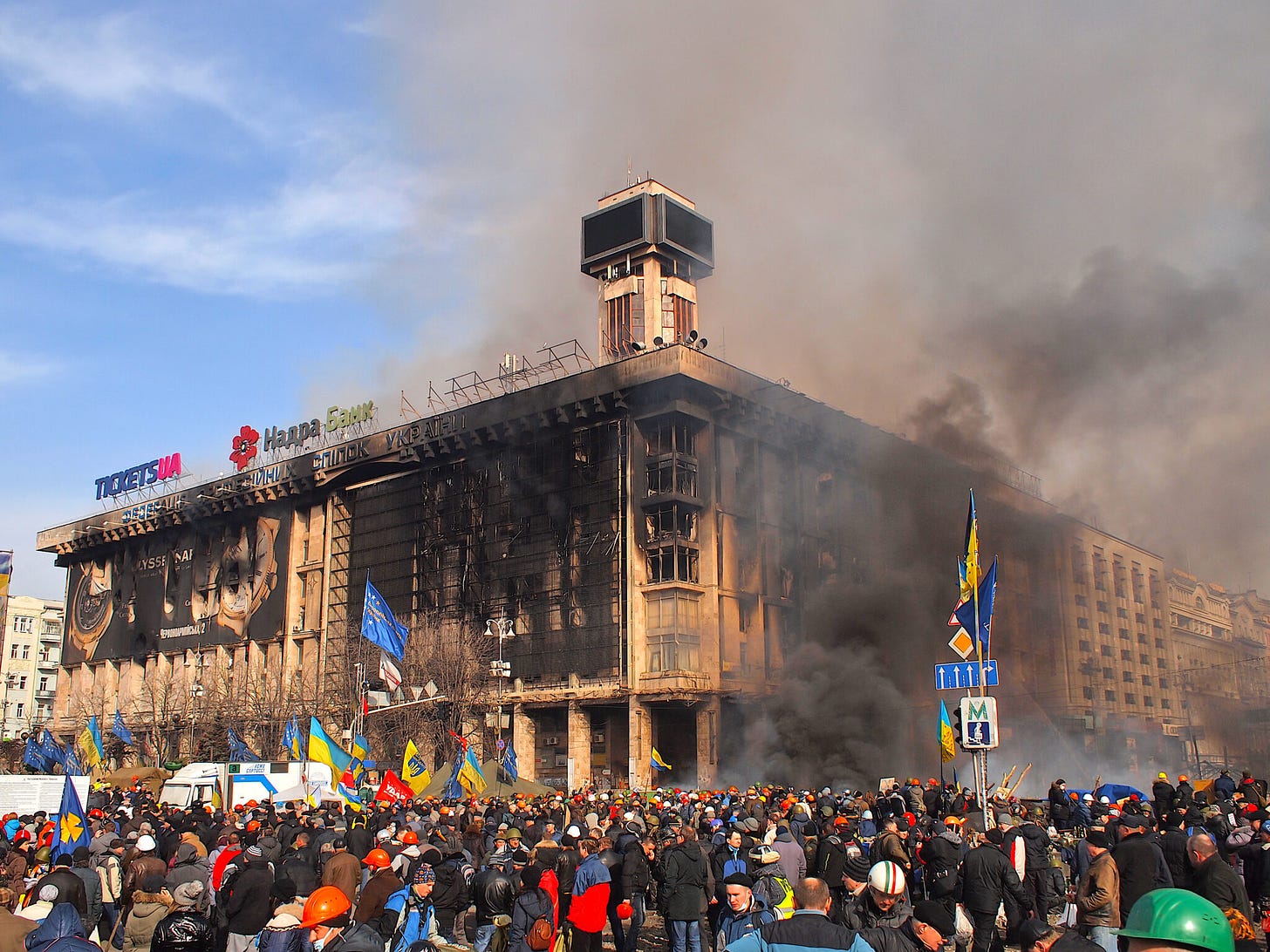
Violence during the Maidan coup in Ukraine, 2014. Source: Wikipedia.
This operation is more commonly known as the Maidan Coup in which demonstrators (against Yanukovych’s government) leadership were riddled with neo-Nazis.
A phone call (transcript here) was leaked to the news media on February 4th, 2014 between U.S. Assistant Secretary of State Victoria Nuland and Geoffrey Pyatt, the then U.S. ambassador to Ukraine.
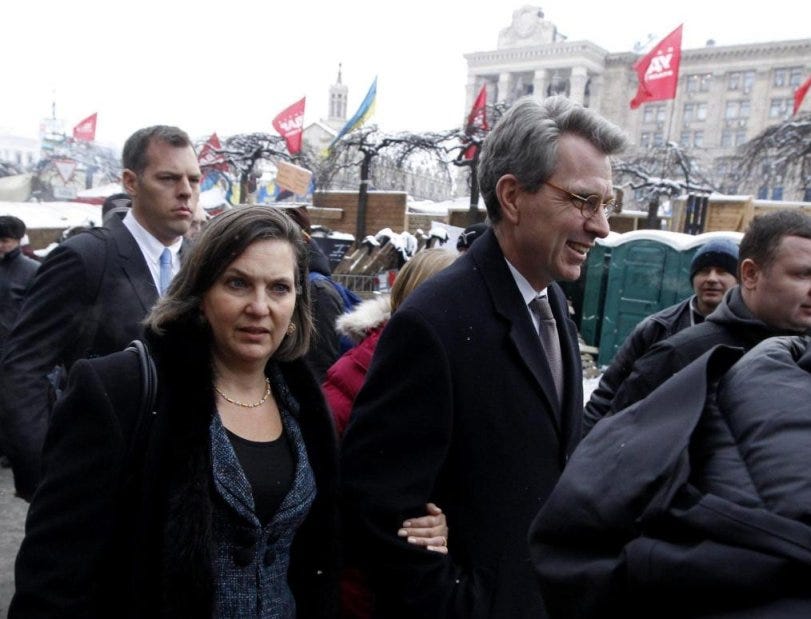
Assistant Secretary of State Victoria Nuland with Geoffrey Pyatt, February 6, 2014.
During the call, they discussed which puppets could be installed in their new government; keep in mind, this is a few weeks before the Maidan Coup had occurred.
Nuland and Pyatt schemed on how they would form the new government post-coup placing “Yats”, Arseniy Yatseniuk as a key plant for the new government.
Arseniy Yatseniuk became the new Prime Minister of Ukraine on February 27, 2014.
And in June of the same year, NATO- and Western-friendly Ukrainian oligarch Petro Poroshenko replaced Yanukovych as the new President of Ukraine in what was a very questionable election.
This phone call is also memorable for its “Fuck the EU” reference uttered by Victoria Nuland. This was in reference to her frustration about how members of the European Union were somewhat divided on relations with Russia and thus not aggressive enough against their Cold War rival.
According to Consortium News, after the U.S.-led coup, Viktor Shokin, Ukraine’s prosecutor general, was investigating corruption allegations about Burisma holdings, a Ukrainian oil & gas giant for which Hunter Biden had been given a lucrative membership to sit on its board of directors.
Threatening to pull a U.S. billion-dollar aid package to the Ukraine, then Vice-President Joe Biden forced Ukrainian President Poroshenko to fire Shokin.
